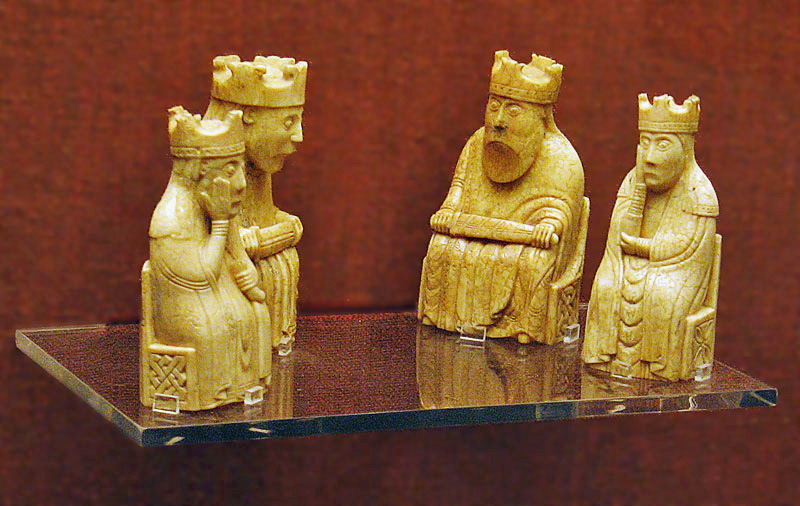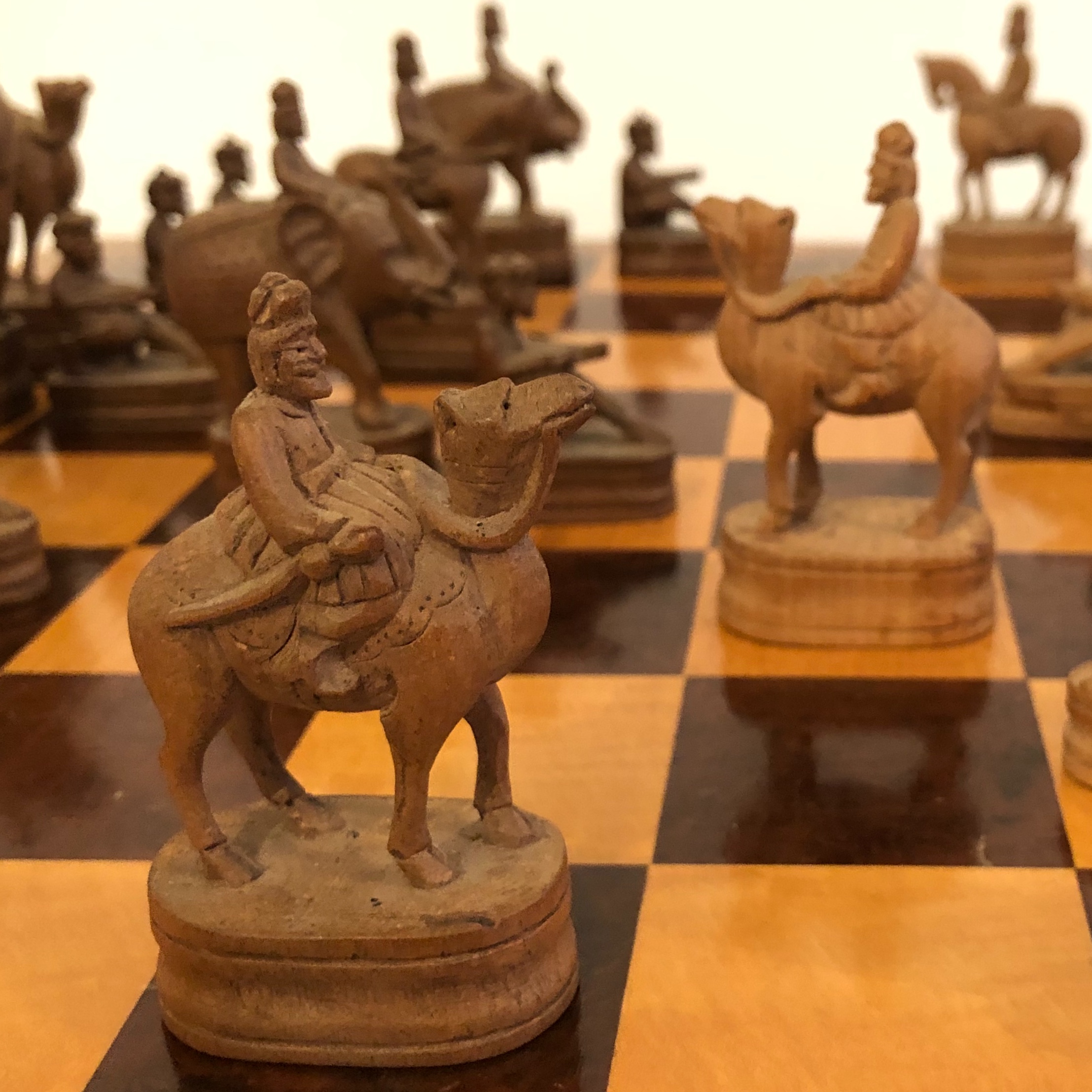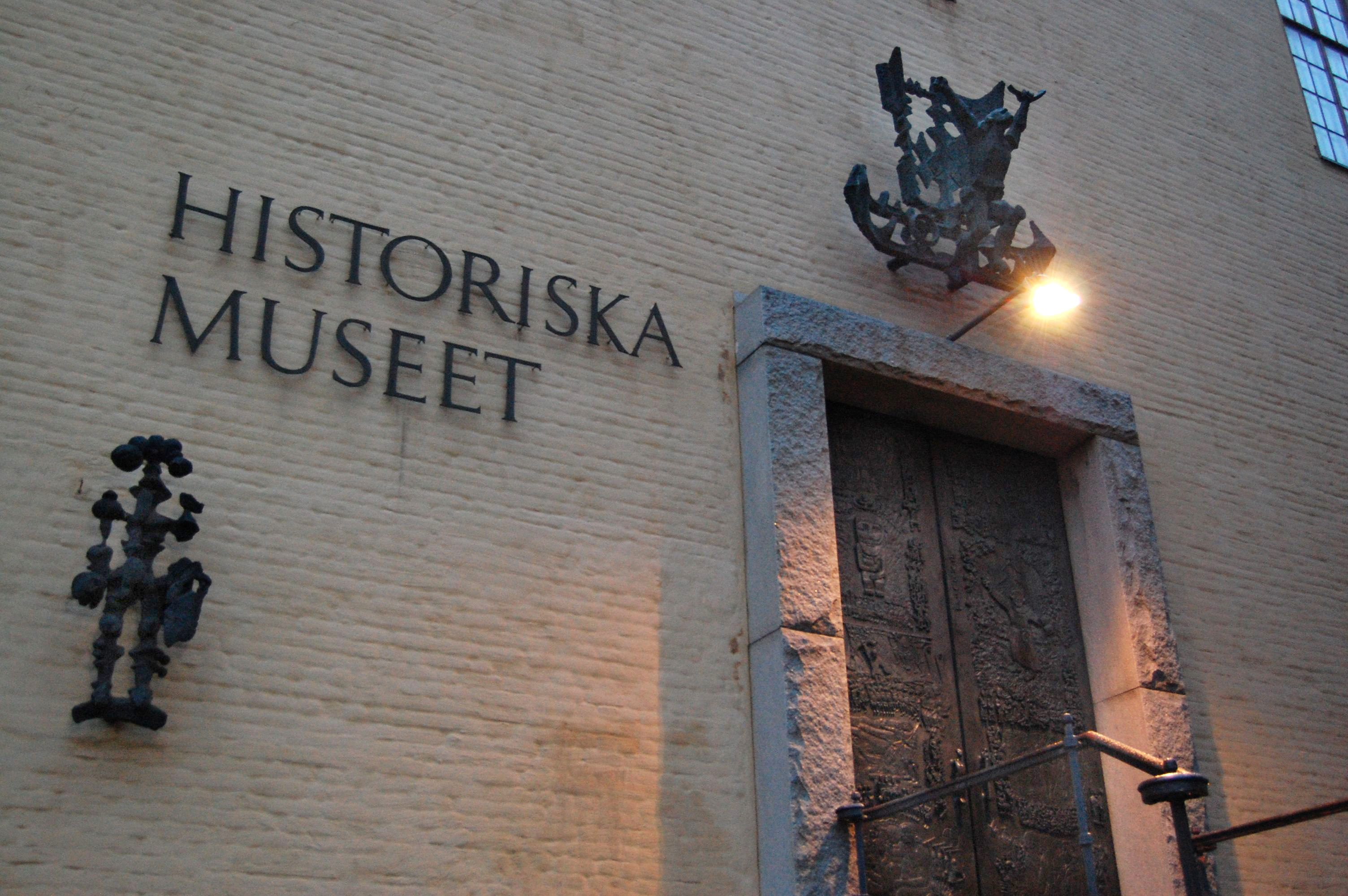|
Lewis Chessmen
The Lewis chessmen ( ) or Uig chessmen, named after the island or the bay where they were found, are a group of distinctive 12th-century chess pieces, along with other game pieces, most of which are carved from walrus ivory. Discovered in 1831 on the Isle of Lewis in the Outer Hebrides of Scotland, they may constitute some of the few complete, surviving medieval chess sets, although it is not clear if a single complete period-accurate set can be assembled from the pieces. When found, the hoard contained 94 objects: 78 chess pieces, 14 tablemen (pieces for backgammon or similar games) and one belt buckle. Today, 82 pieces are owned and usually exhibited by the British Museum in London, and the remaining 11 are at the National Museum of Scotland in Edinburgh; at least one chess piece is owned privately. A newly identified piece, a "warder", the equivalent of a rook, was sold for £735,000 in July 2019. Four other major pieces, and many pawns, remain miss ... [...More Info...] [...Related Items...] OR: [Wikipedia] [Google] [Baidu] |
Camas Uig
Camas Uig (Uig Bay) is a bay on the west coast of the Isle of Lewis, in the Outer Hebrides of Scotland. The bay contains a variety of small islets including Fraoch Eilean, Leac Holm, Sgeir a' Chàis, Sgeir Liath, Sgeir Sheilibhig, Tom and Tolm. Camas Uig is in the parish of Uig and is part of the South Lewis, Harris and North Uist National Scenic Area. In 1831, the 12th-century Lewis Chessmen were discovered in a small stone structure in the dunes behind the beach near Ardroil. Two large wooden chessmen, carved by Stephen Hayward, stand outside a museum on the machair A machair (; sometimes machar in English) is a fertile low-lying grassy plain found on part of the northwestern coastlines of Ireland and Scotland, particularly the Outer Hebrides. The best examples are found on North and South Uist, Harris ... at Ardroil, near where the hoard was found. References Citations Sources * {{coord, 58, 12, 01, N, 7, 01, 01, W, region:GB_type:isle, display=title Isle of ... [...More Info...] [...Related Items...] OR: [Wikipedia] [Google] [Baidu] |
Pawn (chess)
The pawn (♙, ♟) is the most numerous and weakest piece in the game of chess. It may move one square directly forward, it may move two squares directly forward on its first move, and it may capture one square diagonally forward. Each player begins a game with eight pawns, one on each square of their second . The white pawns start on a2 through h2; the black pawns start on a7 through h7. Individual pawns are referred to by the on which they stand. For example, one speaks of "White's f-pawn" or "Black's b-pawn". Alternatively, they can be referred to by the piece which stood on that file at the beginning of the game, e.g. "White's king bishop's pawn" or "Black's queen knight's pawn". It is also common to refer to a ''rook's pawn'', meaning any pawn on the a- or h-files, a ''knight's pawn'' (on the b- or g-files), a ''bishop's pawn'' (on the c- or f-files), a ''queen's pawn'' (on the d-file), a ''king's pawn'' (on the e-file), and a ''central pawn'' (on the d- or e-files). The p ... [...More Info...] [...Related Items...] OR: [Wikipedia] [Google] [Baidu] |
Knight (chess)
The knight (♘, ♞) is a piece in the game of chess, represented by a horse's head and neck. It moves two squares vertically and one square horizontally, or two squares horizontally and one square vertically, jumping over other pieces. Each player starts the game with two knights on the b- and g-, each located between a rook and a bishop. Movement Compared to other chess pieces, the knight's movement is unique: it moves two squares vertically and one square horizontally, or two squares horizontally and one square vertically (with both forming the shape of a capital L). Consequently, a knight alternates between light and dark squares with each move. When moving, the knight can jump over pieces to reach its destination. Knights capture in the same way, replacing the enemy piece on the square and removing it from the board. A knight can have up to eight available moves at once. Knights and pawns are the only pieces that can be moved in the chess starting position. Val ... [...More Info...] [...Related Items...] OR: [Wikipedia] [Google] [Baidu] |
Bishop (chess)
The bishop (♗, ♝) is a Chess piece, piece in the game of chess. It moves and captures along without jumping over interfering pieces. Each player begins the game with two bishops. The starting squares are c1 and f1 for White's bishops, and c8 and f8 for Black's bishops. Placement and movement The is placed on f1 for White and f8 for Black; the is placed on c1 for White and c8 for Black. The bishop has no restrictions in distance for each move but is limited to diagonal movement. It cannot jump over other pieces. A bishop captures by occupying the square on which an enemy piece stands. As a consequence of its diagonal movement, each bishop always remains on one square color. Due to this, it is common to refer to a bishop as a ''light-squared'' or ''dark-squared'' bishop. Comparison – other pieces Versus rook A rook (chess), rook is generally worth about two Pawn (chess), pawns more than a bishop. The bishop has access to only half of the squares on the board, w ... [...More Info...] [...Related Items...] OR: [Wikipedia] [Google] [Baidu] |
Queen (chess)
The queen (♕, ♛) is the most powerful piece in the game of chess. It can move any number of squares vertically, horizontally or , combining the powers of the rook and bishop. Each player starts the game with one queen, placed in the middle of the first next to the king. Because the queen is the strongest piece, a pawn is promoted to a queen in the vast majority of cases; if a pawn is promoted to a piece other than a queen, it is an underpromotion. The predecessor to the queen is the '' ferz'', a weak piece only able to move or capture one step diagonally, originating from the Persian game of shatranj. The queen acquired its modern move in Spain in the 15th century. Placement and movement The white queen starts on d1, while the black queen starts on d8. With the chessboard oriented correctly, the white queen starts on a white square and the black queen starts on a black square—thus the mnemonics "queen gets her color", "queen on er wncolor", or "the dress uee ... [...More Info...] [...Related Items...] OR: [Wikipedia] [Google] [Baidu] |
King (chess)
The king (♔, ♚) is the most important chess piece, piece in the game of chess. It may move to any adjoining square; it may also perform, in tandem with the Rook (chess), rook, a special move called ''castling''. If a player's king is threatened with capture, it is said to be ''in Check (chess), check'', and the player must remove or evade the threat of immediately, such as by moving it away from the attacked square. If this cannot be done, the king is said to be in checkmate, resulting in a loss for that player. A player cannot make any move that places their own king in check. Despite this, the king can become a strong offensive piece in the Chess endgame, endgame or, rarely, the Chess middlegame, middlegame. In Algebraic notation (chess), algebraic notation, the king is abbreviated by the letter ''K'' among English speakers. The white king starts the game on e1; the black king starts on e8. Unlike all other pieces, each player can have only one king, and the kings are never ... [...More Info...] [...Related Items...] OR: [Wikipedia] [Google] [Baidu] |
Rook (chess)
The rook (; ♖, ♜) is a piece in the game of chess. It may move any number of squares horizontally or vertically without jumping, and it may an enemy piece on its path; it may participate in castling. Each player starts the game with two rooks, one in each corner on their side of the board. Formerly, the rook (from ) was alternatively called the ''tower'', ''marquess'', ''rector'', and ''comes'' (''count'' or ''earl''). The term "castle" is considered to be informal or old-fashioned. Placement and movement The white rooks start on the squares a1 and h1, while the black rooks start on a8 and h8. The rook moves horizontally or vertically, through any number of unoccupied squares. The rook cannot jump over pieces. The rook may capture an enemy piece by moving to the square on which the enemy piece stands, removing it from play. The rook also participates with the king in a special move called castling, wherein it is transferred to the square crossed by the king after th ... [...More Info...] [...Related Items...] OR: [Wikipedia] [Google] [Baidu] |
Toothed Whales
The toothed whales (also called odontocetes, systematic name Odontoceti) are a parvorder of cetaceans that includes dolphins, porpoises, and all other whales with teeth, such as beaked whales and the sperm whales. 73 species of toothed whales are described. They are one of two living groups of cetaceans, the other being the baleen whales (Mysticeti), which have baleen instead of teeth. The two groups are thought to have diverged around 34 million years ago (mya). Toothed whales range in size from the and vaquita to the and sperm whale. Several species of odontocetes exhibit sexual dimorphism, in that there are size or other morphological differences between females and males. They have streamlined bodies and two limbs that are modified into flippers. Some can travel at up to 30 knots. Odontocetes have conical teeth designed for catching fish or squid. They have well-developed hearing that is well adapted for both air and water, so much so that some can survive even if they ar ... [...More Info...] [...Related Items...] OR: [Wikipedia] [Google] [Baidu] |
Swedish History Museum
The Swedish History Museum () is a museum located in Stockholm, Sweden, that covers Swedish archaeology and cultural history from the Mesolithic period to present day. Founded in 1866, it operates as a government agency and is tasked with preserving Swedish historical items as well as making knowledge about history available to the public. The origin of the museum is the collections of art and historical objects gathered by Swedish monarchs since the 16th century. It has a number of permanent exhibitions and annually hosts special exhibitions tied to current events. Function The History Museum is part of a central museum agency called the ''Statens historiska museer'' (SHM) ("National Historical Museums"). Other museums under the aegis of this agency are The Royal Armouries, The Economy Museum, Skokloster Castle, The Hallwyl Museum, The Tumba Papermill Museum and The Swedish Holocaust Museum. History The foundation for what was to become the Swedish History Museum and th ... [...More Info...] [...Related Items...] OR: [Wikipedia] [Google] [Baidu] |
The Metropolitan Museum Of Art
The Metropolitan Museum of Art, colloquially referred to as the Met, is an encyclopedic art museum in New York City. By floor area, it is the third-largest museum in the world and the largest art museum in the Americas. With 5.36 million visitors in 2023, it is the most-visited museum in the United States and the fifth-most visited art museum in the world. In 2000, its permanent collection had over two million works; it currently lists a total of 1.5 million works. The collection is divided into 17 curatorial departments. The main building at 1000 Fifth Avenue, along the Museum Mile on the eastern edge of Central Park on Manhattan's Upper East Side, is by area one of the world's largest art museums. The first portion of the approximately building was built in 1880. A much smaller second location, The Cloisters at Fort Tryon Park in Upper Manhattan, contains an extensive collection of art, architecture, and artifacts from medieval Europe. The Metropolitan M ... [...More Info...] [...Related Items...] OR: [Wikipedia] [Google] [Baidu] |
The Courtauld Institute Of Art
The Courtauld Institute of Art (), commonly referred to as The Courtauld, is a self-governing college of the University of London specialising in the study of the history of art and conservation. The art collection is known particularly for its French Impressionist and Post-Impressionist paintings and is housed in the Courtauld Gallery. The Courtauld is based in Somerset House, in the Strand in London. In 2019, the Courtauld's teaching and research activities temporarily relocated to Vernon Square, London, while its Somerset House site underwent a major regeneration project. History The Courtauld was founded in 1932 through the philanthropic efforts of the industrialist and art collector Samuel Courtauld, the diplomat and collector Lord Lee of Fareham, and the art historian Sir Robert Witt. Originally the Courtauld was based in Home House, a townhouse designed by Robert Adam in Portman Square, Marylebone. The Strand block of Somerset House, designed by William Chambers ... [...More Info...] [...Related Items...] OR: [Wikipedia] [Google] [Baidu] |








